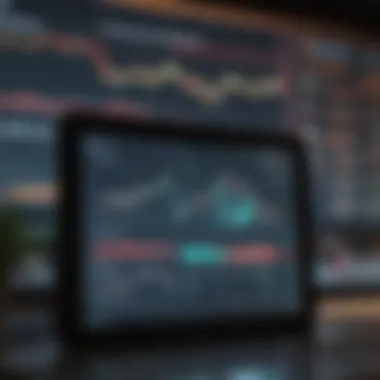Comprehensive Guide to Dow Futures Trading Hours


Intro
Market Overview
Current Market Sentiment
Market sentiment can significantly influence the trading of Dow futures. At any given moment, factors like investor confidence, geopolitical events, or macroeconomic trends can sway sentiment. Keeping an eye on sentiment indicators, such as the CNN Fear and Greed Index, can provide insights into overall market behaviors.
Major Indices Performance
The performance of the major indices has a direct impact on futures trading. The S&P 500, NASDAQ, and of course, the Dow itself can indicate trends that may affect Dow futures. For instance, strong earnings reports or economic growth can propel indices upward, which in turn can lead to bullish futures trading, while negative news may bring about the opposite effect.
Economic Indicators Analysis
Economic indicators are essential to understanding futures trading dynamics. Key reports such as the unemployment rate, GDP growth, and inflation metrics play a vital role. The release of these reports often results in heightened volatility during trading hours. Traders should be aware of scheduled economic releases to make informed decisions.
Stock Analysis
Individual Stock Profiles
Analyzing individual stocks within the Dow is beneficial. Each of the components can impact overall market sentiment. It’s important to assess their financial health, recent activities, and market positioning. For example, companies like Apple and Microsoft can drive market trends due to their significant market capitalizations.
Historical Performance
Reviewing historical performance can provide context for future trading decisions. By analyzing previous market cycles and Dow futures performance, traders can gauge potential outcomes in similar economic conditions.
Valuation Metrics
Understanding valuation metrics such as price-to-earnings ratios and debt-to-equity ratios is important for stock analysis. Each stock carries its own valuation considerations that should be factored into trading strategies.
Technical Analysis Insights
Technical analysis involves examining stock price movements and trading volumes. Analysts utilize charts to identify patterns that can forecast future movements. Traders should be familiar with various technical indicators, such as moving averages and Relative Strength Index (RSI), to better inform their strategies.
Investment Strategies
Long-term vs.
Short-term Investments
Determining whether to engage in long-term or short-term investments is essential. Long-term investments may focus on fundamental analysis, while short-term trading often involves technical strategies to capitalize on quick market movements.
Diversification Techniques
Diversification can mitigate risks. Traders should consider spreading their investments across different assets. This can involve participating in various sectors or asset classes outside of Dow futures.
Risk Management Practices
Risk management is crucial when trading futures. Traders must set stop losses and position sizes to prevent substantial losses. This practice is fundamental, particularly in volatile markets.
Recommended Asset Allocations
Allocation of assets involves determining the percentage of capital to assign to different investments. A well-thought-out allocation strategy can help balance risk and return.
Sector Analysis
Growth Sectors Overview
Identifying growth sectors within the market allows traders to target opportunities. Technology, healthcare, and renewable energy are sectors that have shown substantial growth potential.


Sector-Specific Risks and Opportunities
Each sector has unique risks and opportunities. Understanding how economic changes affect different sectors can help inform better investment strategies. For instance, interest rate fluctuations can greatly impact real estate investments.
Comparative Analysis among Sectors
Conducting a comparative analysis between sectors can reveal potential areas for growth. Such an analysis can assist traders in deciding where to direct their investments.
Emerging Trends in Specific Sectors
Awareness of emerging trends is vital. Trends can arise from new technologies, changes in consumer behavior, or shifts in regulatory environments. Keeping updated with these developments can provide valuable insights for trading strategies.
Financial Education Resources
Terminology and Concepts
Investing requires understanding specific terminology. Familiarity with terms like
Overview of Dow Futures
Understanding Dow futures is crucial for anyone involved in the financial markets. Dow futures serve as an early indicator of how the market will perform based on the performance of the Dow Jones Industrial Average. They offer traders a unique opportunity to speculate on the future direction of the market, making them an integral part of trading strategies.
Definition of Dow Futures
Dow futures are financial contracts that allow investors to buy or sell the anticipated future value of the Dow Jones Industrial Average. Specifically, these contracts are based on the index's price movement. When traders engage with Dow futures, they do not own the actual stocks within the index but are instead speculating on the index's future movement. This trading mechanism enables participants to take risks or hedge positions in their portfolios effectively.
Importance in Financial Markets
The significance of Dow futures spans several domains within the financial ecosystem. First, they provide liquidity, which is essential for maintaining a healthy trading environment. Participants can quickly enter or exit positions, enhancing overall market efficiency. Additionally, Dow futures play a pivotal role in price discovery. The prices set in the futures market often reflect real-time analysis of market sentiments and events, allowing investors to make informed decisions.
Moreover, the ability to trade Dow futures outside regular market hours equips traders with the flexibility to respond to overnight developments, such as economic reports or geopolitical events. This capability can lead to a more balanced risk management approach, ensuring that traders can protect or enhance their investments even in a turbulent market.
"Dow futures are critical indicators that help investors envision market trends before they unfold in the underlying stock market."
In summary, understanding Dow futures not only aids in grasping market dynamics but also empowers traders to strategize more effectively.
Trading Hours Explained
Trading hours in the context of Dow futures are fundamental for both trading strategy and market participation. Understanding these hours can greatly influence trading decisions, risk management, and overall performance in the futures market. The timing of trades often correlates with volatility, liquidity, and price movements, making it essential for traders to be well-informed about when to engage with the market.
Standard Trading Hours
Standard trading hours for Dow futures typically align with the regular hours of the Chicago Mercantile Exchange. This period usually runs from 8:30 AM to 3:15 PM Central Time. During these hours, the market experiences its highest liquidity and activity levels. Traders can expect a greater number of participants, which can contribute to tighter spreads and more efficient price discovery. This is the most favorable time for both new and experienced traders, as the increased volume can lead to more reliable technical analysis signals.
Key Points:
- Trading generally takes place during weekdays, excluding holidays.
- Most price movements occur within these hours.
- Major economic reports and corporate news often release in this timeframe.
Extended Trading Hours
Extended trading hours refer to the time frame before and after the standard session. For Dow futures, this typically encompasses pre-market hours from 6:00 PM to 8:30 AM Central Time and after-hours trading from 3:15 PM until 5:00 PM Central Time. While these periods allow for increased flexibility in trading, it is important to note that liquidity can be significantly lower compared to standard hours. This may result in wider price spreads and potentially higher risks.
Considerations for Extended Trading:
- Important to track overnight news and global events.
- Be mindful of potential price gaps when standard hours reopen.
- Utilize limit orders to manage risks effectively.
Differences Between Futures and Stocks
Understanding the distinctions between futures trading and stock trading is crucial. Stock markets generally operate on a set trading schedule, usually from 9:30 AM to 4:00 PM Eastern Time. In contrast, futures markets, especially for the Dow, have a more extended trading period that offers advantages and disadvantages.
Key Differences:


- Market Availability: Futures often trade nearly 24 hours, providing opportunities across different time zones.
- Volatility: Futures can be more volatile outside standard trading hours, which may suit certain trading strategies.
- Risk Management: Futures require distinct risk management strategies that account for overnight and extended hour risks, unlike stocks.
Understanding trading hours is not just about when to trade; it is about how market dynamics change during different periods.
Detailed Schedule of Dow Futures Trading
The Dow futures trading schedule plays a pivotal role in how traders and investors engage with the market. Understanding this schedule is essential to maximizing opportunities and minimizing risks. Each segment of the trading hours can influence price movements and market behaviors.
Regular Trading Session
The regular trading session is often seen as the heart of the futures trading day. It generally begins at 9:30 AM and concludes at 4:00 PM Eastern Time. During this time, the majority of trading volume occurs. Investors should pay close attention to this period for several key reasons.
- Liquidity: The regular session provides higher liquidity due to the involvement of institutional traders and retail investors. This can result in tighter spreads and less slippage.
- Price Discovery: Prices during this session are more reflective of the market's consensus on value, influenced by economic data releases and corporate news.
- Activity Peaks: Certain times within this session see increased trading activity, particularly at market open and close.
It is vital for traders to build strategies around this session to capitalize on its strengths.
Pre-Market Trading Hours
Pre-market trading hours present a distinct environment for futures trading, typically spanning from 4:00 AM to 9:30 AM Eastern Time. While it offers opportunities, caution is advised.
- Lower Volume: Typically, trades during this time see significantly lower volume, which can lead to less reliable price movements.
- Impact of News: Important overnight news can trigger significant market reactions. Being alert to economic indicators or geopolitical events during this period is crucial.
- Limited Orders: Traders need to adjust their order strategies, given that not all instruments may be available for trading. This period requires careful planning.
Being aware of these elements allows traders to use pre-market trading effectively.
After-Hours Trading
After-hours trading occurs from 4:00 PM to 8:00 PM Eastern Time. This segment complements the regular hours but comes with unique characteristics and hurdles.
- Volatility: This session can experience high volatility. Traders may find sharp price movements due to lower participation.
- Limited Information: Post-market releases can play a critical role. Understanding how earnings reports or economic news affect market sentiments is important.
- Risk Considerations: Without vigilant risk management, traders can easily experience significant losses in these hours. Adapting strategies for this peculiar trading period is vital for success.
By comprehending the detailed schedule of Dow futures trading, investors can position themselves advantageously in the market. Ignoring the schedule may lead to missed opportunities or unforeseen losses.
Factors Influencing Trading Hours
The trading hours of Dow futures are not just mere timelines; they are significantly influenced by various factors that traders must consider. Understanding these factors is crucial for anyone involved in the trading arena. It helps in strategizing trades effectively and can also present opportunities to capitalize on market movements. Key elements such as market demand and supply, economic events, and geopolitical shifts directly impact the trading hours and market behavior.
Market Demand and Supply
Market demand and supply determine the pricing and activity levels of Dow futures. When there is high demand for futures contracts, it often leads to increased trading volume. Conversely, low demand results in less activity. During certain hours, the market may experience shifts in supply due to economic indicators or news releases, affecting how traders respond.
Higher demand can also result in tighter spreads between buying and selling prices. This may encourage more trading activity as the costs to enter a position are minimized. Time zones play an essential role too. Most traders in the U.S. may react to global events and prices established overnight, creating fluctuations in prices during the opening hours.
Economic Events
Economic events are pivotal for instigating market reactions. Reports on unemployment rates, inflation, and gross domestic product (GDP) influence traders' sentiments toward Dow futures. For example, if the U.S. Department of Labor announces a significant drop in unemployment, traders may buy futures contracts anticipating a bull market.
Reports scheduled to release at specific times can lead to spikes in trading volume and volatility. Therefore, it is critical that traders keep a calendar of important economic events, as these can drastically alter trading dynamics and hours. Investors who prepare to react to these events have better chances of benefiting from market shifts. Educating oneself about economic indicators is a vital part of successful trading strategy.
Geopolitical Events
Geopolitical events are yet another factor influencing trading hours. Events such as elections, trade negotiations, or conflicts can lead to uncertainty in the market. For instance, news of a potential trade deal between the U.S. and China could result in increased trade activity in futures, leading to rapid price movements.
Traders must be cognizant of global tensions as they can cause unexpected volatility. In times of crisis or uncertainty, trading volume may increase dramatically. This can lead to extended trading times as investors rush to adjust their portfolios. Thus, paying attention to political situations is essential for staying ahead in the futures market.
In summary, the trading hours for Dow futures are significantly shaped by factors such as market demand and supply, economic events, and geopolitical occurrences. Understanding these elements allows traders to make informed decisions and optimize their trading strategies.
Strategic Considerations for Traders
Strategic considerations are critical for anyone involved in Dow futures trading. Traders must think carefully about when and how they engage with the market. Understanding the nuances of trading hours can greatly influence both their approach and outcomes. Before making trades, awareness of the timeframe is essential as it impacts liquidity, volatility, and overall market conditions.
Best Times to Trade


Timing is key in Dow futures trading. The market operates in phases, each with different characterisics. Generally, the key trading periods are during regular sessions. However, the pre-market and after-hours portions also present opportunities.
- High Liquidity Times: Regular trading hours usually see the most activity. The best times to trade are often the first and last hours of the market day, where investor activity peaks.
- Pre-Market Dynamics: Traders can also look to pre-market hours. These times can offer insights based on overnight news and might set the stage for the regular session.
- After-Hours Movements: Similarly, after-hours trading can reveal investor sentiment responding to news that breaks post-market. This time can see less liquidity, often leading to sharper moves.
Being aware of these periods can aid in developing trading strategies that are more in line with market conditions.
Risk Management Techniques
Risk management is a vital skill every trader should possess. In the context of Dow futures trading, this involves identifying threats to your capital and taking steps to mitigate them. Here are a few core techniques:
- Set Stop-Loss Orders: A fundamental practice is setting stop-loss orders. This allows for automatic exits at defined loss points, safeguarding capital even in adverse conditions.
- Limit Position Size: It’s advisable to limit the number of contracts you trade. This helps control exposure and prevents catastrophic losses in volatile situations.
- Diversifying Your Trades: Avoid focusing solely on one type of futures contract. By diversifying, one can spread out the risk across various assets.
Implementing these techniques establishes a more disciplined approach and helps weather market uncertainties.
Technical Analysis During Different Hours
Technical analysis, which involves studying past market data, is a useful tool in future trading. The effectiveness of specific indicators can vary based on trading hours.
- Use of Moving Averages: During high volume trading hours, moving averages can provide insights into trends. Their predictive ability often increases with the number of participants in the market.
- Volume Indicators: Keeping an eye on volume during different trading sessions can give clues regarding potential reversals or continuation patterns.
- Chart Patterns: Certain chart patterns may present more clearly during specific trading periods. For example, head and shoulders may form differently in after-hours trading due to lower volume.
Traders should practice analyzing data rigorously at different times. This balanced approach can yield better decision-making and enhance overall trading performance.
Strategic planning in futures trading is not just about when to enter or exit the market, but understanding how time affects your positions.
Common Mistakes in Futures Trading
Understanding common mistakes in futures trading is crucial for both novice and experienced traders. Learning from the missteps of others can save significant financial losses and enhance trading strategies.
Ignoring Trading Hours
One common mistake is ignoring the specific trading hours of Dow futures. Each trading session can have unique characteristics influenced by market conditions. Dedicating time to observe these hours allows traders to identify when the market is most active and volatile, providing opportunities for profiting. Failing to recognize the importance of these timeframes can lead to missed chances or unanticipated losses.
Moreover, each trading hour has its own market behavior due to varying levels of trader participation and market news. For instance, the pre-market and after-hours periods can be more unpredictable. Therefore, being aware of this environment is essential in making informed decision.
Overtrading During Volatile Hours
Another mistake is overtrading, particularly during volatile hours. Many traders feel tempted to engage aggressively when they observe unexpected price movements. This approach can lead to hasty decisions and ultimately result in substantial losses.
Traders should exercise caution and develop a solid plan that outlines specific entry and exit points instead of reacting impulsively to market fluctuations. Risk management techniques, such as setting stop-loss orders, become essential tools to mitigate harmful effects of volatility.
Failing to Prepare for Market Events
A significant error many traders make is failing to prepare for scheduled market events. Economic reports, earnings releases, or significant geopolitical news can influence market conditions dramatically. Not having a plan to adapt to these events can lead to missed opportunities or unexpected losses.
Traders should keep an economic calendar to track upcoming events and analyze how they might impact market prices. This preparation is valuable for anticipating potential volatility and ensuring that trading positions align with overall market sentiment. Understanding and anticipating these events can greatly enhance trading outcomes and profits.
Closure
In the realm of Dow futures trading, understanding the trading hours is essential for success. Traders and investors must grasp both the regular and extended trading sessions to make informed decisions. This article outlines critical considerations, emphasizing the nuances of timing in trading. Knowing when market participants are active can significantly influence trading strategies.
Effective trading requires a comprehensive grasp of the schedule of Dow futures trading. It allows investors to identify optimal times for entering or exiting positions. Recognizing how economic and geopolitical events impact trading hours further provides a well-rounded perspective.
Moreover, the article emphasizes the common pitfalls associated with futures trading, such as the dangers of ignored trading hours and the risks inherent in overtrading during volatile times. Grasping the summarized key points discussed herein prepares traders to navigate the complexities of the futures market. As the landscape of Dow futures evolves, traders will benefit by staying informed and adapting their strategies accordingly.
Understanding trading hours is not just about knowing times. It's about leveraging that knowledge to enhance trading outcomes.
Summary of Key Points
- Definition and Importance: Dow futures serve as a barometer for market performance and economic indicators. They allow traders to speculate on future price movements.
- Detailed Schedule: Regular trading sessions typically run from 6 PM to 5 PM EST, with pre-market and after-hours sessions that provide additional opportunities.
- Influencing Factors: Market demand, supply, and major economic or geopolitical events can shift trading hours, impacting volume and price volatility.
- Strategic Considerations: Optimal trading times and adhering to risk management principles are crucial for successful futures trading.
- Common Mistakes: Ignoring trading hours and failing to prepare for market-moving events can severely impact trading outcomes.
Future of Dow Futures Trading
As the financial markets evolve, the future of Dow futures trading appears promising yet challenging. Advances in technology and the growing accessibility of trading platforms have democratized access to futures markets, enabling more participants. We are likely to see a continued increase in global market integration, which may affect trading hours.
Adapting to changes in market structure is crucial. Traders must stay abreast of regulatory developments and emerging trends that might influence trading dynamics. Moreover, the rise of algorithmic trading can significantly impact price movements during different trading hours, warranting an adaptive strategy.
Ultimately, as new economic indicators and geopolitical factors emerge, those involved in Dow futures trading must develop agile trading approaches. Understanding trading hours will remain a central component of navigating this increasingly complex landscape.



